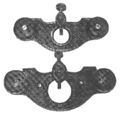RouterPlanes
This is the original Metal Router Type Study Page created by Lars Larson in 1996 and published by Jay Sutherland. These pages were lost for some time then later rescued and republished with permission of the original publisher.
Metal Router Manufacturers
Metal routers were sold by the companies listed below, though some companies actually had their routers manufactured by others. The Stanley router design is based on a patent granted to Henry Cope in 1884.The amount of information presented on router models varies from company to company.
Marples
Millers Falls
Ohio Tool
Phelps
Preston
Record
Sargent
Stanley
Winchester
Router Patents 1883-1916
272,801 H. L. Tupper Feb. 20, 1883
294,724 H. P. Cope Mar. 4, 1884 Assigned to Stanley
350,352 J. L. De Huff Oct. 5, 1886
378,854 J. A. Trout Feb. 28, 1888 Assigned to Stanley
420,232 G. Heymeier Jan. 28, 1890 Of Bremen, Germany
609,681 A. J. Kniffen Aug. 23, 1898
685,411 A. F. Schade Oct. 29, 1901 Assigned to Stanley
707,085 F. Clayton Aug. 19, 1902 Of Pudsey, England
717,883 R. P. Mathews Jan. 6, 1903 To Sandusky Tool Co.
793,297 F. Hesley Jun. 27, 1905
865,560 G. H. Bartlett Sep. 10, 1907 Assigned to Stanley
902,977 A. Link Nov. 3, 1908
1,012,591 E. A. Schade Dec. 26, 1911 Assigned to Stanley
1,026,053 T. B. Saner May 14, 1912 Assigned to Stanley
1,031,509 B. Aylor Jul. 2, 1912
1,195,799 C. Fink Aug. 22, 1916
With only sixteen routers patented between the years 1883 and 1916, note that six of them, almost 40%, were assigned to Stanley.
Henry Cope
Origins of the Stanley No. 71 Router Plane
Henry Cope was a pattern maker working for the Detroit Stove Works when he patented his first router plane in 1884. (Patent No. 294,724: filed January 12, 1884 and granted March 4, 1884.)
Design Changes
Cope modified his first router model (Type 1) by redesigning the cutter locking collar (Type 2).
Cashing In
Cope sold his router plane patent rights to Stanley Rule & Level Co. in 1884. Later that year Stanley introduced it's No. 71, a slightly larger version of Cope's router plane.
Trivia Corner
John Henry Bissell was an attorney who owned half the rights to Cope's router patent. He was born in 1846, and his law offices were located at 80 Griswald Street, Detroit, MI. He must have been very prominent as he had a telephone in 1884. Henry Cope lived at 215 McDougall Avenue, Detroit, MI for the years 1884 and 1885. His brother George also worked at the Stove Works. In 1886 Cope quit his job and opened his own business, The Excelisior Stove Pattern Company, at 59-61 Fort Street in Detroit. Henry Cope was listed as President, with his brother George as Secretary and Treasurer. I would venture that this all came about with the money he received from selling the patent to Stanley Rule & Level Co. All this not being enough, he was married in 1886 to Catherine (the Widow) Philps. Things must have continued to go well for him, as he had a telephone installed by 1889.
John L. De Huff
John L. De Huff of Reading Massachusetts patented his router on October 5, 1886. A special feature of this router is its two-piece base, which allows the throat width to be adjusted for any size blade. It also came with guides which attach to the base.
Ken Kutter
Production History Keen Kutter did not manufacture any routers, but had a large output in the hardware business by way of the E. C. Simmons Co. The first catalog numbers KK 71 and KK 171 1/2, were produced by the Ohio Tool Co. from 1907 to 1908. The second set of numbers, K171 1/2 and K171, were manufactured by the Stanley Tool Co. from 1908 until Keen Kutter went out of business.
Keen Kutter Open Throat Router
- Kk 171 2.gif
Type 2. K171 - 1908-
Keen Kutter Closed-Throat Router
- Kk 171 2.gif
Type 2. K171 - 1908-Type 2. K171 1/2 - 1908- The Type 2. had the Stanley 1901 patent date on it.
Acknowedgements
Lars Larson wishes to thank the following people for helping with this metal router type study: Dave Heckel Kerry McCalla Ron Pearson Allen Foster Tom Lamond Bill Badde Alice Larson Reg Eaton







